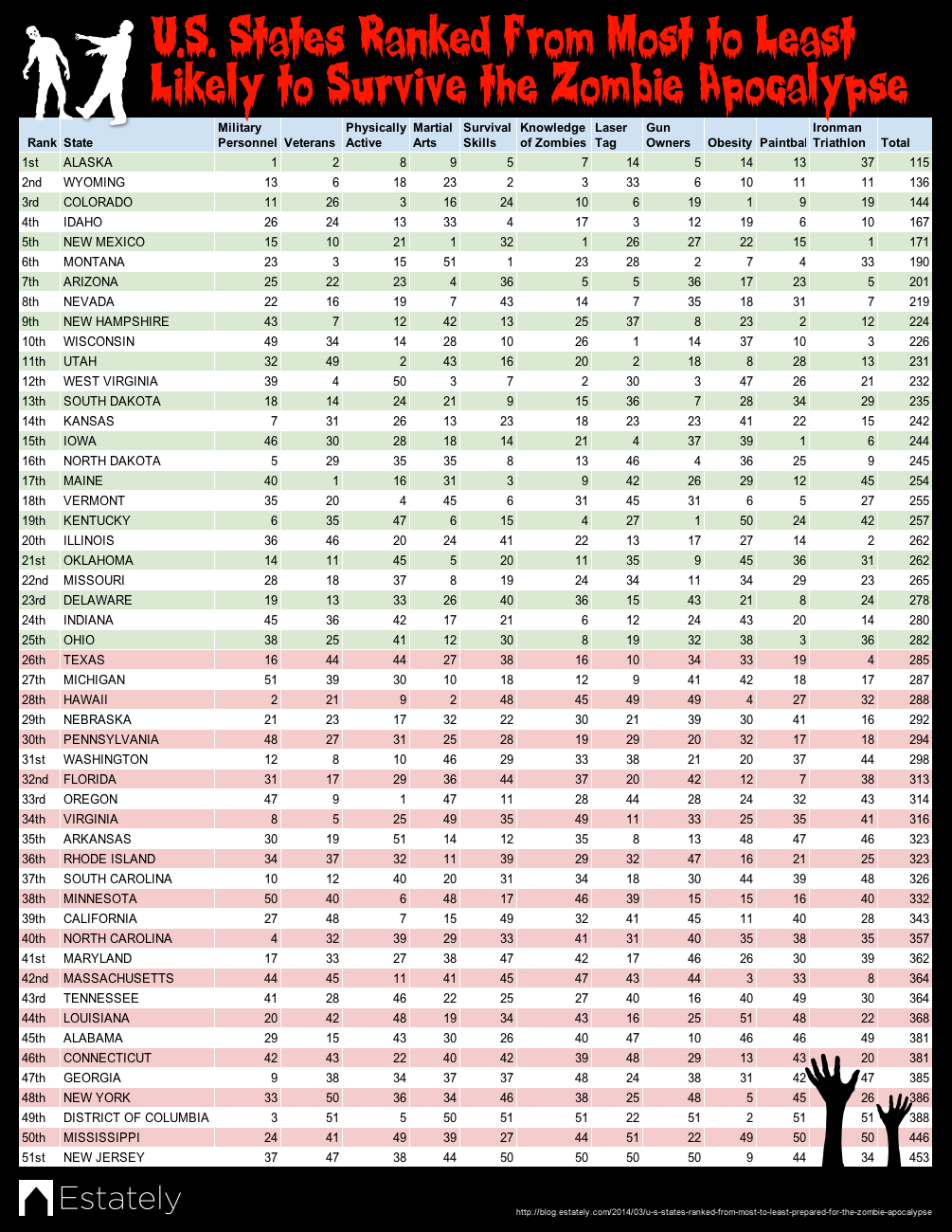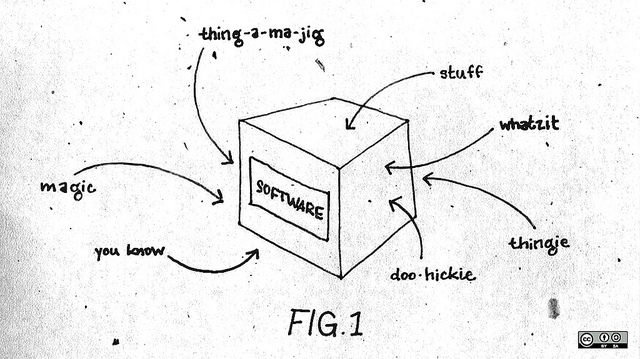fuck me! :o lol if it's not vamp's,were's,et's,goobers,gobber's,shit in the attic..coming outta the attic,walls,drains,fucking showers,this pipe, that fuck~in pipe ....ass pipes , grem's (that god damn STRIPE LOL ) pred's ,trolls,pixie's trixies .... fucking ~a member when zomb's were slow ,stupid :) & NOW the motherfuckers R ...organ~niz~in ...carl lewis fucking fast !!! WTF gaints,fallen fucking angels ....fuck me :o
 Given the growing frequency with which zombies appear in movies, TV
shows, and your worst nightmares, it’s inevitable the zombie apocalypse
will soon be upon us. When it comes to surviving this inevitable
showdown with the undead, location is everything. Do you live in a state
populated with zealous zombie fighters capable of beating back hordes
of brain-hungry walking dead? Estately answered this question with its Zombie Apocalypse Preparedness Rankings,
which were determined using the 11 metrics below that measure fighting
ability, knowledge of zombies, physical fitness, and access to weapons…
Given the growing frequency with which zombies appear in movies, TV
shows, and your worst nightmares, it’s inevitable the zombie apocalypse
will soon be upon us. When it comes to surviving this inevitable
showdown with the undead, location is everything. Do you live in a state
populated with zealous zombie fighters capable of beating back hordes
of brain-hungry walking dead? Estately answered this question with its Zombie Apocalypse Preparedness Rankings,
which were determined using the 11 metrics below that measure fighting
ability, knowledge of zombies, physical fitness, and access to weapons…- Active Military Personnel: States with more soldiers per capita means states with more people who are physically fit, trained to fight, and have access to weapons (source).
- Military Veterans: Percentage of veterans per capita is a solid way of measuring fighting experience (source).
- Physically Active: States with residents who rarely get out of their Laz-E-Boy will not escape the zombie menace (source).
- Martial Arts Enthusiasts: Hand-to-hand combat is an important skill when the ammo runs out (source—percentage of Facebook users who listed “martial arts” as an interest).
- People with Survival Skills: In the long run, knowing how to survive without modern conveniences in a collapsed society will be critical (source—percentage of Facebook users who listed “survival skills” as an interest).
- People with Knowledge of Zombies: To know your enemy you must know their ways (source—percentage of Facebook users who listed “zombies, Resident Evil, Zombieland, and The Walking Dead” as interests).
- Laser Tag Enthusiasts: Yes, laser tag. Few things prepare you for a zombie attack in enclosed space (source—percentage of Facebook users who listed “laser tag” as an interest).
- People with Guns: Shooting a zombie in the head is really the best way to defeat a zombie, and to do that you need a gun (source).
- Obesity: The obesity epidemic will yield to the zombie epidemic because the obese will struggle with running away from zombies. It’s really very simple (source).
- Paintball Enthusiasts: Those who can slink around the woods unnoticed while splattering their enemies with paint will find success shooting zombies in nature (source—percentage of Facebook users who listed “paintball” as an interest).
- Triathletes: When everything breaks down, running, swimming, and bicycling will be ideal ways to escape zombies (source—percentage of Facebook users who listed ”Ironman triathlon” as an interest).
From the rankings, we discovered these surprising truths…
- Delaware is an island of survivors in the zombie-strewn hellscape that will be the Mid-Atlantic.
- Florida, where the zombie apocalypse (like all serious problems) will no doubt begin, is oddly not in 51st place.
- Wisconsin can now make fun of Minnesota and Michigan about something other than the Green Bay Packers standing in the NFC North.
- New Jersey and Mississippi routinely end up on the bottom of lists. All lists.
- Rural states offer favorable survivability.
- Something’s wrong with Nebraska.
- Utah loves laser tag.
- The West Coast and the South will eventually agree on something—the delicious appeal of brains.
Profile of the 10 States Most Prepared To Survive Zombie Apocalypse
RYAN NICKUM
1st—ALASKAIn a state where residents run from bears and moose, they will not be scared of slow-moving corpses. Alaska is packed with military personnel and veterans, and they’re only a fraction of the well-armed Alaskans prepared to shoot zombies from a moving snowmobile.
2nd—WYOMING
No other state has a shared love of zombie movies and guns like Wyoming. While New Yorkers are having their brains eaten in cafes and elevators, the fine people of Wyoming will be sitting on the front porch with a shotgun enjoying a prolonged zombie hunting season.
3rd—COLORADO
Coloradans are well known to be among the most physically fit in the country so when zombies start crawling out of their graves, most of the state’s residents will be miles away, easily jogging up a 10,000-foot mountain.
4th—IDAHO
If a horde of zombies stumbles into Lewiston, Idaho they’re going to have their hands full. Idahoans are physically active, heavily armed, and are hard to catch because they’re oddly really into parkour.
5th—NEW MEXICO
This state knows its zombie facts (from movies and TV shows), but it’s also full of triathletes and martial enthusiasts. Not only can residents escape from zombies by running, swimming, or biking, but they can also turn around and dole out some beat downs like the ninja assassins they are.
6th—MONTANA
The state’s residents previously prepared to face the zombie apocalypse, but that was because pranksters hacked into a TV station’s EAS and broadcasted a message that the zombie apocalypse had begun. Had that not been a test, those zombies would have experienced the full wrath of Montana’s arsenal because that state is heavily armed.
7th—ARIZONA
Home to both the Department of Zombie Defense and the Arizona Zombie Defense Force. The state of Arizona trains for the zombie apocalypse with zombie walks, a Zombie Night at an Arizona Diamondbacks game, and much more.
8th—NEVADA
Las Vegas is home to the Zombie Apocalypse Store, so it’ll be easy to buy supplies to fend off the walking dead. Cities around the state are already prepping with zombie pub crawls, a state run zombie prevention site, and more.
9th—NEW HAMPSHIRE
New Yorkers fleeing a zombie apocalypse will drive up real estate prices when the move to the Granite State, the most prepared in the Northeast.
10th—WISCONSIN
Should the zombies enter an office building in Wisconsin, they’ll face a large number of people prepared to shoot zombies in confined areas because Wisconsin is home to the most laser tag enthusiasts per capita in America. Wisconsin is awesome. Click HERE for proof.
.
PROFILE OF 10 STATES THAT WILL DEFINITELY NOT SURVIVE A ZOMBIE APOCALYPSE
WIKIMEDIA COMMONS
42nd—MASSACHUSETTSDespite being physically fit, residents of Massachusetts are almost completely lacking in knowledge of zombies. Ignorance is not bliss, it’s very costly in a zombie apocalypse.
43rd—TENNESSEE
The Tennessee Zombie Response Unit has its work cut out for it because the rest of state is ill prepared to battle the undead. Tennesseans should abandon their company softball teams and form paintball teams instead.
44th—LOUISIANA
For Louisiana, the downside of letting the good times roll is it makes it very difficult outrun the living dead. Lack of physical fitness and limited knowledge of zombies dooms the great state of Louisiana… once it runs out of ammunition.
45th—ALABAMA
Here’s a plan—Alabama confronts its obesity by training for the Alabama Biathalon. It’s a variation of the winter sport, but instead of cross-country skiing you just run around the woods with a gun shooting at everything. It’s like hunting season, but you can’t bring a 24-pack of beer.
46th—CONNECTICUT
Residents of Connecticut should either begin playing laser tag or start seasoning themselves because if the zombie apocalypse started today they’d get eaten up as appetizers.
47th—GEORGIA
Even though The Walking Dead is set in Georgia, residents there have little interest in zombies. In the event of a zombie apocalypse, the undead will discover Georgia brains are as sweet as Georgia peaches.
48th—NEW YORK
If there were New York travel brochure for zombies it would tout the state’s lack of veterans, limited enthusiasm for survival skills, and scarcity of firearms.
49th—DISTRICT OF COLUMBIA
Our nation’s capital has almost no knowledge of zombies, martial arts, or firearm ownership. It’s going to be an all-you-can-eat brain buffet for the zombies.
50th—MISSISSIPPI
M-I-S-S-I-S-S-I-P-P-Die. Everybody is going to die. From zombies.
51st—NEW JERSEY If the zombie apocalypse began today, and you live in New Jersey, the odds are 100% that you’ve already been bitten and have become a zombie, unless you took a course from New Jersey’s own Zombie Survival Course. It’s real, and it could definitely save your life… even though they criticized our article (video proof).
Check out these articles about our zombie list…
CNET: When the zombie apocalypse hits, pray you’re in AlaskaWall Street Journal: If a Zombie Epidemic Hits, New Jersey Is Screwed (Map)





























